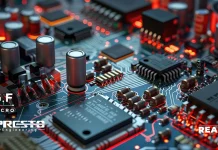Imagine driving in a car that can detect and avoid collisions. How? Automotive 3D light detection and ranging sensors, popularly known as LiDAR, provide a 360 degree vision for autonomous cars to enable the ultimate driving experience.
LiDAR systems use high-speed laser beams to observe a full vision of the surrounding environment of the vehicle which are converted into real-time 3D graphics. The automotive industry has undergone several changes and transformed into a highly versatile market. Autonomous vehicles are gaining momentum with assisted technologies and the commercialization of self-driving cars in recent times.
“But do we really need these LiDAR systems in our cars?” Let’s take a simple example. When you are reversing your vehicle, your car’s camera is only able to provide a 90 to 120 degree vision, however LiDAR technology is capable of providing drivers with a 360 degree view. This is essential for improving efficiency and safety of the vehicle.
So, what is “driving” the emergence of autonomous 3D light detection and ranging technologies in today’s fast-paced world?
From GPS Tracking to Collision Prediction: LiDAR in Autonomous Cars
Automotive LiDAR is emerging as an integral step in the automation of vehicles. LiDAR gathers information based on the surrounding environment which is processed in the computerized system to devise a human-like decision.
With technological advancements and the introduction of modern cars with advanced sensing, detection and control, LiDAR systems are equipped with avoidance systems that provide collision warning. When driving an autonomous vehicle, drivers get prompts for through detection systems for avoiding collisions with other vehicles or obstacles.
The high-resolution capabilities of automotive LiDAR systems allow the system to determine the size, shape and location of obstacles in the vicinity of the vehicle, which are critical for object detection and collision avoidance at any speed.
General Motors recently unveiled their new semi-autonomous driving system priced at a whopping $300,000. You must be wondering, what skyrocketed the price? An upgrade of its predecessor Super Cruise, Ultra Cruise is a self-driving Chevy vehicle providing up to 400,000 miles of compatibility with highways in the United States and Canada. With integrated LiDAR sensors, radar, GPS and 3D cameras, the
What are the Various Types of Automotive LiDAR Sensors?
Light imaging, detection and ranging are essential for scanning and detecting objects in the vicinity of the vehicle. With the onset of rapid technological advancements, automotive LiDAR sensors are essentially classified into two categories based on the technology it utilizes and performs tasks with:
- Electro-Mechanical LiDAR: Traditional LiDAR systems are classified under the umbrella of electromechanical LiDAR. These can be termed as the first generation LiDAR sensors that are widely utilized in automotive applications. Electromechanical LIDARs are quite heavy, very pricey, and vulnerable to damage in rough terrains. They are mounted on the top of the vehicle and continuously scan the area by performing rotatory movements.
- Solid State LiDAR: Built on a single chip, solid state LiDAR systems emit, receive and process information to notify drivers. Due to their compact size, these microchips are lightweight, not visible upon installation and also cost efficient. They are usually affixed in the rear, front and sides of the vehicle to gather data. For instance, Velodyne LiDAR is a brand which has established a global customer footprint by providing innovative, high performance hardware and software solutions to drivers.
What Challenges are Limiting the Growth of Automotive LiDAR?
Automotive LiDAR serves as the eyes of the self-driving vehicle. Even though technology improves the driving experience and assists cars to operate safely, there are certain drawbacks that have been observed in these micro sensors. Here are a few of the concerning issues:
- Weather Conditions: During natural calamities including log, heavy rainfall, thunderstorms or dense fog, the accuracy of the LiDAR sensors may be hampered, causing problems for the driver. This is likely to pose challenges to the driver and endanger his safety.
- Traffic & Driving Laws: The traffic rules and regulations of every country differ, and to embed these features into the automotive LiDAR systems may hinder its growth since it will be more regionally-accepted where it is manufactured.
- Accountability of Accidents: Unforeseen circumstances are eventual. Even though LiDAR systems are equipped with high-resolution cameras and sensors, that does not guarantee the system to avoid all types of obstacles. In case of being unable to detect the type of object in the way, there may be software vulnerabilities that emerge. In such a situation, it would be difficult to pose accountability on either the driver or the vehicle manufacturer.
LiDAR Defining Intelligent Transportation in Years to Come?
The rising detrimental impacts of conventional vehicles on the environment has led to the emergence of tackling climate change. Electric cars and self-driving vehicles are 75% efficient while converting input energy into kinetic energy, enabling them to decrease air pollution and ultimately lower carbon emissions. Due to these factors, automotive LiDAR systems have witnessed a significant boom in recent years.
Automobile manufacturers are constantly evolving to stay updated with the latest technologies and stay ahead of the competition in the market. For instance, Volvo recently launched its “most advanced vehicle yet” by the name of Volvo EX90 which is an EV crossover that features a LiDAR bump on its roof to enable autonomous operation.
Furthermore, the LiDAR technology also allows scientists and area mapping professionals to examine natural and manmade environments with utmost accuracy and precision. For instance, National Oceanic and Atmospheric Administration (NOAA), gathers geospatial and topographic data of the United States with the help of LiDAR sensors.
As we continue to proceed with automotive LiDAR systems capable of 3D mapping capabilities which are able to differentiate between the type of obstacle ahead of it, it is evident that the growth of these systems would be driven by continuous advancements that keep popping up in the market.
The high integration of automotive LiDAR technology is expected to improve efficiency, convenience and safety of drivers by gathering information from external surroundings. Will all modern cars begin adopting LiDAR systems? Ideally, that would contribute to the safety of the driver exponentially. However, only time will be able to give us a certain answer in the near future!
Browse More Posts:-
Smart Door Lock Market
Smart Toilet Seats Market
Smart Toilet Market
Intelligent Parcel Locker Market




